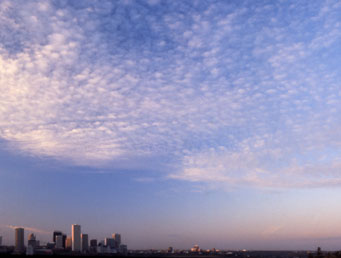When I was a child growing up in New York City and New York State, I would occasionally see a car from Montana with the motto "Big Sky Country" on its license plate. It seemed like a really dumb phrase. Don't we all live under the same sky? Isn't it the same size for everyone?

A mackerel sky looms over Edmonton, Alberta. The short-grass prairie, from the Rocky Mountains east to longitude 100°, is America's native big-sky country.
Wikimedia Commons
Then, after two years of college, when I was fed up with taking meaningless courses, I traveled out West and finally understood. Far from being a truism, Big Sky Country captures the essence of the high prairie, the vast grassland east of the Rocky Mountains. Back home, the only times I'd ever seen the whole sky at once was from a handful of mountaintops. Everywhere else, the horizon was limited in most directions by buildings, hills, and above all, trees. Out in the prairie, the sky is all around; you can see thunderstorms coming 50 miles away. It's humbling and somewhat scary -- like the old fisherman's prayer: "Lord, help me, for thy sea is so great and my boat is so small."
Amazing as the big sky is by day, it's far more so at night, when it's full of texture and detail. There's nothing quite like lying on your back under a completely unobstructed sky, seeing stars everywhere you look. It's an experience that's taken for granted in the American West, especially the prairie and the desert, and completely alien to most Easterners.
It's not that I don't like trees, mind you. On a purely practical level, they're one of our best defenses against light pollution and noise pollution. And aesthetically, there's nothing to match them. But it's nice to have places where you can get away from the trees and see the sky. And in my habitat, all cleared areas are impermanent. Trees can be felled by humans, beavers, disease, or wind, but they always come back again -- and quickly, too.
If you do all your stargazing from your backyard, then you've almost certainly never seen the whole sky at once. Part of the sky is inevitably blocked by your home, and much more is probably hidden by trees. Try searching out the nearest big cleared space -- a park or ball field, meadow or beach. It's well worth the trouble. The majesty of the night sky just isn't the same when you can only see it through gaps in the trees.
 1
1
Comments
Greg
July 30, 2007 at 1:52 pm
My daughter just got back to Nebraska from 4 years of college in Washington DC. Every time she returns home, she always comments on how much she misses the sky. Last night when I picked her up from the airport, she said "Home. Home cooking and big skies."
Although Omaha doesn't have as much light pollution as some otehr cities, it's still pretty bad. My observing site is about 20 miles west of Omaha. I've got zenith to horizon visibility in nearly 360' with only a few stands of trees a mile or more away. Every night I observe, I find 15-20 minutes at the end of the session to simply marvel at the sky in all directions. Tony is correct in that we in the west take it for granted. My daughter reinforces that to me several times each year.
You must be logged in to post a comment.
You must be logged in to post a comment.